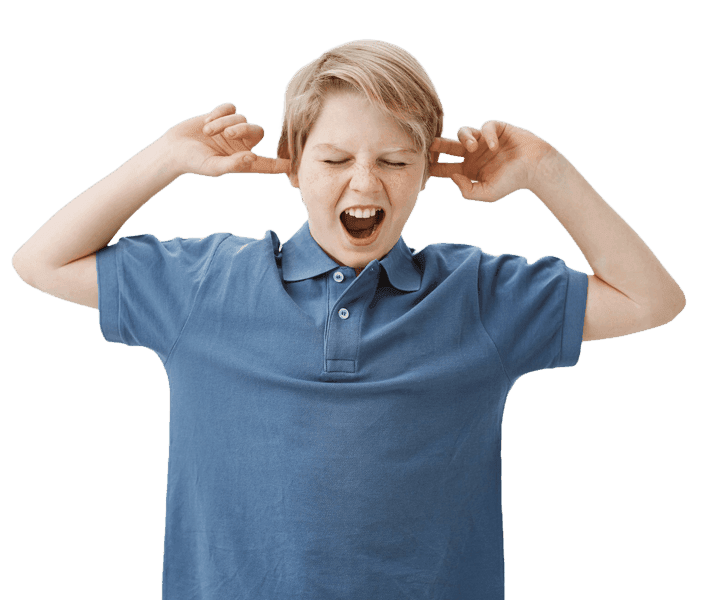SIGNS AND SYMPTOMS

Childhood behavioural disorders explained
ADHD / ADD
Attention deficit hyperactivity disorder (ADHD) is a chronic condition affecting millions of children, with symptoms often continuing into adulthood. Children with ADHD will often present with hyperactivity and / or inattentiveness. While most children will experience periods of inattentiveness or impulsive hyperactivity, for children with ADHD their inability to concentrate or regulate their emotions can impact their schooling, learning abilities and friendships.
There are three subtypes of ADHD – predominantly inattentive, predominantly hyperactive / impulsive and the third is a combination of the first two.
Signs of Inattentiveness include:
- Lack of attention to detail
- Struggling to stay focused / on task
- Zoning out or daydreaming
- Disorganisation
- Easily distracted
- Forgetfulness and misplacing possessions
- Unable to follow simple instructions
Signs of Hyperactivity and Impulsiveness include:
- Unable to sit still, specifically in a quiet environment
- Constant fidgeting or excessive physical movement
- Struggling to stay focused and on task
- Excessive talking
- Interrupting and unable to wait their turn
- Acting without forethought
- Little or no sense of danger.
Genes such as the MTHFR gene have been shown to play a role in ADHD. If you would like to understand how your child’s genes might be affecting their learning, concentration or hyperactivity order a Complete Genetic Health Package.
AUTISM
The autism spectrum is a range of neurodevelopmental conditions which can manifest differently from person to person. Autism is characterised by poor social skills, difficulty with expressive communication and the presence of controlling or repetitive behaviours. For some people with autism the condition can be debilitating, whilst for others it is very manageable and simply a different way of learning and interacting with the world. Autism is usually diagnosed in childhood and perpetuates into adulthood.
Signs & Symptoms of autism in children include:
- Avoiding eye contact
- Hypersensitivity to certain tastes, smells and sounds
- Intolerance of certain textures, clothing
- Repetitive movements and conversations
- Quiet disposition, less talkative, or not talking at all
- Fixation on certain interests and repetitive conversations
- Struggling to understand what others are thinking or feeling
- Thriving in routine and getting very upset when there is disruption.
- Difficulty expressing themselves and struggling to regulate emotions
- Difficulty making friends
MTHFR and genes that affect histamine, oxalates and neurotransmitters (brain chemicals) like serotonin, dopamine, GABA, norepinephrine, epinephrine may all influence a child’s ability to learn, concentrate, focus, talk and express themselves. Understand how this might be affecting your child by undergoing a Complete Genetic Health Package.
TANTRUMS
Tantrums in childhood are an expression of deep frustration and an inability to manage or soothe big emotions. Tantrums are most common between the ages of 1 and 3 years old, but can perpetuate into school years. For younger children who cannot communicate effectively, a tantrum may be the result of emotions that have no other way of being released. For older children, tantrums can continue because they have not learned or been demonstrated how to manage their emotions effectively. A child’s neurotransmitter levels will control and influence these tantrums. For example, high dopamine may be the cause of these tantrums. Balancing neurotransmitter levels, is often key in reducing or eliminating these tantrums.
High dopamine can be triggered by yeast infections or exposure to mould or gut bacteria like clostridia so testing for environmental causes is key to assisting those with anger issues.
Many genes, such as MTHFR, COMT (catechol o methyltransferase), GAD (glutamate decarboxylase), MAO A (Monoamine oxidase), Histamine related genes and Oxalate related genes have been shown to play a role in tantrums and other learning disorders, understand how this might be affecting your child by ordering a Complete Genetic Health Package.
SEIZURES – ABSENCE SEIZURES
Absence seizures might be brought on by a knock to the head, an infection or even typical school infections like impetigo. Often a child will grow out of it, however it is best to address this as soon as possible so that the child can have better learning outcomes. While absence seizures occur in the brain, they don’t cause brain damage. Absence seizures won’t have any effect on intelligence in most children. Some children may experience learning difficulties because of their lapses in consciousness. Others may think they’re daydreaming or not paying attention.
It is thought that multiple genetic changes or a combination of genetic and environmental factors contribute to development of the condition. Polymorphisms in GABRG2 have been associated with a spectrum of seizures and generalised epilepsy syndromes, with phenotypes that range from simple febrile seizures to childhood absence seizures.
Understand how genes such as GBRGG2 may be involved if your child is experiencing absence seizure by completing a Complete Genetic Health Package.


